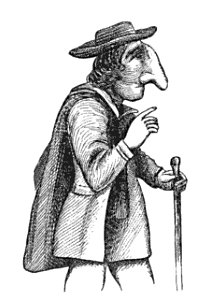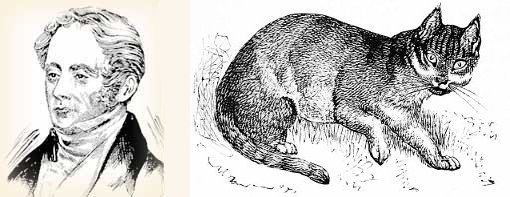Psychologist Adelbert Ames, inventor of the Ames room, also devised this illusion. In which direction is the window turning?
Oddities
Divine Recall
One of the most marvelous feats of recent times was performed in August, 1897, at Sondrio, capital of the Valtellina district, in the northern part of Italy, by Signor Edoe, professor in the Institution di Lorenzo, who, on a wager, repeated from memory, and without making a single mistake, the whole of Dante’s immortal poem, ‘Divina Commedia,’ which consists of nearly one hundred cantos, an amount of matter about equal to the number of words contained in the New Testament. The feat occupied about twenty-four hours in its accomplishment, lasting from 6 p.m. on one day until 2 p.m. the following day. It was achieved in the presence of a committee of associate professors and literary men, who, at about midnight, divided into two parties, alternately sleeping and listening until the recitation was finished, the text being carefully followed by prompters during the whole time, all in order that there might be no question as to the genuineness of the performance. This feat was accomplished after a preparation that was comparatively short, considering the great length of the poem, and is perhaps the most wonderful exhibition of verbal recollection in recent times.
— Henry H. Fuller, The Art of Memory, 1898
For What It’s Worth

The longest nose in history, 7.5 inches, belonged to Thomas Wedders, who was exhibited throughout Yorkshire in the 1770s.
In Anomalies and Curiosities of Medicine (1901), George Milbry Gould writes, “This man expired as he had lived, in a condition of mind best described as the most abject idiocy.”
“The accompanying illustration is taken from a reproduction of an old print and is supposed to be a true likeness of this unfortunate individual.”
Working Late

For twenty-five years past an oral addition to the written standing orders of the native guard at Government House, near Poona, had been communicated regularly from one guard to another, on relief, to the effect that any cat passing out of the front door after dark was to be regarded as His Excellency the Governor, and to be saluted accordingly. The meaning of this was that Sir Robert Grant, Governor of Bombay, had died there in 1838, and on the evening of the day of his death a cat was seen to leave the house by the front door and walk up and down a particular path, as had been the Governor’s habit to do, after sunset. A Hindu sentry had observed this, and he mentioned it to others of his faith, who made it a subject of superstitious conjecture, the result being that one of the priestly class explained the mystery of the dogma of the transmigration of the soul from one body to another, and interpreted the circumstance to mean that the spirit of the deceased Governor had entered into one of the house pets. It was difficult to fix on a particular one, and it was therefore decided that every cat passing out of the main entrance after dark was to be regarded as the tabernacle of Governor Grant’s soul, and to be treated with due respect and the proper honours. This decision was accepted without question by all the native attendants and others belonging to Government House. The whole guard, from sepoy to subadar, fully acquiesced in it, and an oral addition was made to the standing orders that the sentry at the front door would ‘present arms’ to any cat passing out there after dark.
— Sir Thomas Edward Gordon, A Varied Life, 1906
Return to Sender
On Sept. 30, 1826, a beachcomber found a bottle in the surf at Barbados. Inside was a penciled note:
The ship the Kent, Indiaman, is on fire. Elizabeth, Joanna, and myself commit our spirits into the hands of our blessed Redeemer; His grace enables us to be quite composed in the awful prospect of entering eternity. Dun. McGregor. 1st of March, 1825. Bay of Biscay.
Strangely, the note’s author arrived a short time later. Duncan MacGregor, now a lieutenant colonel in the 93rd Highlanders, had been a major bound for India when the Kent took fire. After he and his family had been rescued by a passing brig, an explosion aboard the burning vessel had cast the bottle into the sea, and it had floated across the Atlantic as if to rejoin him.
A regimental historian confirmed the story after MacGregor’s death in 1881. “[The note] is still preserved by his son, who was at the time of the loss of the Kent a child of only five weeks old, and was the first saved from the wreck.”
(Thanks, Evan.)
Skyward

In 1964, as the Apollo program prepared to land a man on the moon, it received unexpected news from Zambia. “I’ll have my first Zambian astronaut on the moon by 1965,” announced Edward Mukaka Nkoloso, a grade-school science teacher and director-general of the Zambian National Academy of Space Research.
“We are using our own system, derived from the catapult,” he explained. It would fire a 10-foot aluminum and copper rocket that would carry 10 Zambian astronauts ultimately to Mars.
“I’m getting them acclimatized to space travel by placing them in my space capsule every day. It’s a 40-gallon oil drum in which they sit, and I then roll them down a hill. This gives them the feeling of rushing through space. I also make them swing from the end of a long rope. When they reach the highest point, I cut the rope — this produces the feeling of free fall.”
Unfortunately, “I’ve had trouble with my spacemen and spacewomen,” Nkoloso complained. “They won’t concentrate on spaceflight; there’s too much lovemaking when they should be studying the moon. Matha Mwamba, the 17-year-old girl who has been chosen to be the first woman on Mars, has also to feed her 10 cats, who will be her companions on her long space flight.”
The U.N. denied the £700 million Nkoloso needed “to really get going,” but his enthusiasm remained undiminished. In 1968 he congratulated the returning Apollo 8 team but urged: “Let us make a Zambian rocket today. We shall never be content to remain behind other races. This is our heavenly destiny, our natural ambition and cultural hegemony.”
Survival of the Fittest
In 1499, a bear which had been terrorizing a German village and had killed people, was captured and brought to trial. The attorney appointed to defend the bear was allowed to argue for days that the animal had the right to be judged by a jury of its peers (that is, other bears). However, the animal was tried and convicted by human beings. It was sentenced to dangle from the public gallows until relatives of its victims stoned the bear to death.
— Thomas J. Gardner and Victor Manian, Criminal Law: Principles, Cases and Readings, 1975
Wanted
If you see a kangaroo wearing a man’s waistcoat with $20 in one pocket, please notify William Thompson, farmer of Grafton, near Sydney, Australia. When Thompson found a kangaroo caught in a wire fence he acted on impulse, removing his old waistcoat and buttoning it firmly on the kangaroo, which then bounded away. It was several hours later when he remembered the money in the pocket.
— The Paris News, Feb. 4, 1946
Exercises

One summer afternoon in 1917, Royal Flying Corps trainee Graham Donald prepared to try a new maneuver with his Sopwith Camel. He ascended into a vertical loop, intending to flip the plane at the top and fly off in the opposite direction. Unfortunately, when the airplane was fully inverted at 6,000 feet, his safety belt gave way and “suddenly I dived clean through it and fell out of the cockpit.”
“The first 2,000 feet passed very quickly, and terra firma looked damnably ‘firma,'” he recalled later. But as he fell, “I began to hear my faithful little Camel somewhere nearby.” He dropped onto the diving plane and managed to grip its top wing, “and that saved me from slithering straight through the propeller, which was glistening beautifully in the evening sunshine.”
As the ground neared at 140 mph, he reached into the cockpit and pulled back on the control stick. Unfortunately, this sent the plane into an inverted spin. With 2,500 feet left, Donald managed to put his right foot on the stick and push it forward, and he found himself clinging to a plane that was flying upside down. He reached the controls, righted the plane, and climbed into the cockpit with about 800 feet to spare. To prevent further strain on the wings, he cut the engine and glided back to the airfield.
“I made an unusually good landing, but there was no one there to applaud — every man-jack of the squadron had mysteriously disappeared. After a minute or so, heads began to appear all over the place — popping up like bunny rabbits from every hole. Apparently, when I had pressed my foot on the control stick, I’d also pressed both triggers and the entire airfield had been sprinkled with bullets. Very wisely, the ground crew dived as one man for the nearest ditch.”
(From Joshua Levine’s 2008 book On a Wing and a Prayer. Thanks, Paul.)
“A Unique Will”
At a dinner for law alumni of New York University in 1907, Walter Lloyd Smith of the New York Supreme Court read “the most remarkable document that ever came into his possession” — the will of an inmate of the Cook County Insane Asylum at Dunning, Ill.:
I, Charles Lounsbury, being of sound mind and disposing memory, do hereby make and publish this, my last will and testament, in order as justly as may be to distribute my interest in the world among succeeding men.
That part of my interest which is known in law and recognized in the sheep-bound volumes as my property, being inconsiderable and of no account, I make no disposal of in this my will.
My right to live, being but a life estate, is not at my disposal, but these things excepted all else in the world I now proceed to devise and bequeath.
Item: I give to good fathers and mothers, in trust for their children, all good little words of praise and encouragement, and all quaint pet names and endearments, and I charge said parents to use them justly and generously, as the needs of their children may require.
Item: I leave to children inclusively, but only for the term of their childhood, all and every, the flowers of the fields, and the blossoms of the woods, with the right to play among them freely according to the customs of children, warning them at the same time against thistles and thorns. And I devise to children the banks of the brooks, and the golden sands beneath the waters thereof, and the odors of the willows that dip therein, and the white clouds that float high over the giant trees. And I leave the children the long, long days to be merry in, in a thousand ways, and the night and the moon and the train of the Milky Way to wonder at, but subject nevertheless to the rights hereinafter given to lovers.
Item: I devise to boys jointly all the useful idle fields and commons where ball may be played; all pleasant waters where one may swim; all snowclad hills where one may coast, and all streams and ponds where one may fish, or where, when grim Winter comes, one may skate; to have and to hold the same for the period of their boyhood. And all meadows with the clover blossoms and butterflies thereof, the woods and their appurtenances, the squirrels and the birds, and echoes and strange noises, and all distant places which may be visited, together with the adventures there found. And I give to said boys each his own place at the fireside at night, with all pictures that may be seen in the burning wood, to enjoy without let or hindrance and without any incumbrance of care.
Item: To lovers I devise their imaginary world with whatever they may need; as the stars of the sky; the red roses by the wall; the bloom of the hawthorn; the sweet strains of music, and aught else by which they may desire to figure to each others the lastingness and beauty of their love.
Item: To young men jointly, I devise and bequeath all boisterous, inspiring sports of rivalry, and I give to them the disdain of weakness and undaunted confidence in their own strength, though they are rude; I give them the power to make lasting friendships, and of possessing companions, and to them exclusively I give all merry songs and brave choruses, to sing with lusty voices.
Item: And to those who are no longer children or youths or lovers, I leave memory, and I bequeath to them the volumes of the poems of Burns and Shakespeare and of other poets, if there be others, to the end that they may live over the old days again, freely and fully, without tithe or diminution.
Item: To our loved ones with snowy crowns I bequeath the happiness of old age, the love and gratitude of their children until they fall asleep.
The original, it turns out, was written by Williston Fish in 1897 and published in Harper’s Weekly the following year. He had intended it as a poetic trifle, but newspapers around the country had picked it up and run it as fact, often embellishing the language, until, Fish wrote in 1908, “this one of my pieces has been translated into all the idiot tongues of English.” Charles Lounsbury was the name of an old relative of his — “a big, strong all-around good kind of man,” but not, evidently, insane.
